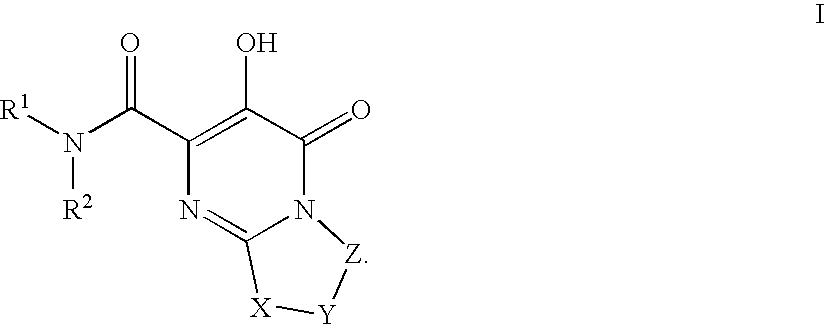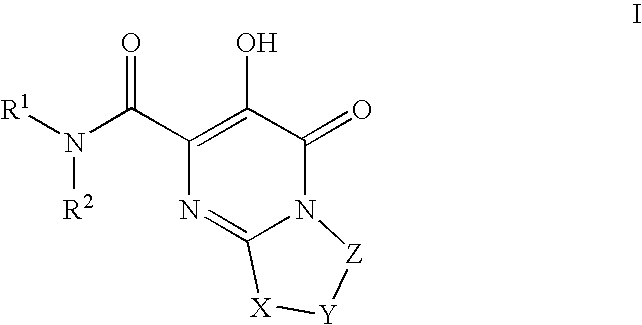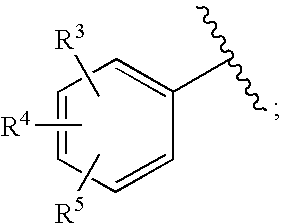Bicyclic heterocycles as HIV integrase inhibitors
a technology of integrase inhibitors and bicyclic heterocycles, which is applied in the direction of heterocyclic compound active ingredients, biocides, drug compositions, etc., can solve the problems of large number of patients who fail to respond to this therapy and not all patients are responsiv
- Summary
- Abstract
- Description
- Claims
- Application Information
AI Technical Summary
Benefits of technology
Problems solved by technology
Method used
Image
Examples
examples 1 – 3
EXAMPLES 1–3
[0092]
[0093]Ethyl 3-(benzyloxy)-8,8-dimethyl-4-oxo-4, 6,7,8-tetrahydropyrrolo[1,2-a]pyrimidine-2-carboxylate. A stirred solution of ethyl benzyloxyacetate (3.88 g, 0.02 mol) and diethyl oxalate (2.92 g, 0.02 mol) in 30 mL tetrahydrofuran was treated portion-wise with 60% NaH (800 mg, 0.02 mol) under N2 at room temperature. A few drops of ethanol were added and stirring continued for 7 days, after which the mixture was concentrated in vacuo. The remaining residue was dissolved in 30 mL ethanol and to it was added a solution of 3,3-dimethylpyrrolidin-2-imine (1.12 g, 0.01 mol, prepared using a literature method). The mixture was treated with NaH (400 mg, 0.01 mol; 60% oil dispersion) and triethylamine (2 grams) then stirred for 16 hrs. The solvent was removed in vacuo and the remaining residue dissolved in CH2Cl2 and washed with H2O. The organic layer was dried and concentrated to give a dark oil. This was purified by chromatography on silica gel eluting with 9:1 CH2Cl2:et...
example 1
[0098]
[0099]N-(4-Fluorobenzyl)-3-hydroxy-8,8-dimethyl-4-oxo-4,6,7,8-tetrahydropyrrolo[1,2-a]pyrimidine-2-carboxamide. The title compound was prepared from intermediate 5 and 4-fluorobenzyl amine using Method A. 1H NMR (300 MHz, CDCl3) δ ppm: 12.12 (1H, s), 7.93 (1H, br), 7.26–7.33 (2H, m), 6.98–7.07 (2H, m), 4.56 (2H, d, J=6.2 Hz), 4.00–4.08 (2H, m), 2.00–2.09 (2H, m), 1.28 (6H, s); HRMS (ESI) calcd for C17H19FN3O3 (M+H) 332.1410, found 332.1394.
[0100]
[0101]N-(4-Fluoro-2-(methylcarbamoyl)benzyl)-3-(benzyloxy)-8,8-dimethyl-4-oxo-4,6,7,8-tetrahydropyrrolo[1,2-a]pyrimidine-2-carboxamide. Intermediate 6, 3-(benzyloxy)-8,8-dimethyl-4-oxo-4,6,7,8-tetrahydropyrrolo[1,2-a]pyrimidine-2-carboxylic acid, (79 mg, 0.25 mmol) was placed together with O-(7-azobenzotriazol-1-yl)-1,1,3,3-tetramethyluronium hexafluorophosphate, HATU, (114 mg, 0.3 mmol) in 2 mL DMF under N2 and stirred for 20 min. 4-(Dimethylamino)pyridine, DMAP, (100 mg, 0.8 mmol) and intermediate 3, 2-aminomethyl-5-fluoro-N-methylbe...
example 2
[0102]
[0103]N-(4-Fluoro-2-(methylcarbamoyl)benzyl)-3-hydroxy-8,8-dimethyl-4-oxo-4,6,7,8-tetrahydropyrrolo[1,2-a]pyrimidine-2-carboxamide. Intermediate 7, N-(4-fluoro-2-(methylcarbamoyl)benzyl)-3-(benzyloxy)-8,8-dimethyl-4-oxo-4,6,7,8-tetrahydropyrrolo[1,2-a]pyrimidine-2-carboxamide was treated with trifluoroacetic acid, according to Method D to provide the title compound 1H NMR (300 MHz, CDCl3) δ ppm: 12.12 (1H, br), 8.71 (1H, br), 7.47 (1H, dd, J=8.1, 5.5 Hz), 7.05–7.2 (2H, m), 6.26 (1H, br), 4.59 (2H, d, J=6.6 Hz), 3.95–4.06 (2H, m), 3.00 (3H, d, J=4.8 Hz), 1.99–2.08 (2H, m), 1.31 (6H, s); HRMS (ESI) calcd for C19H22FN4O4(M+H) 389.1625, found 389.1625.
PUM
| Property | Measurement | Unit |
|---|---|---|
| resistance | aaaaa | aaaaa |
| viral resistance | aaaaa | aaaaa |
| common organic techniques | aaaaa | aaaaa |
Abstract
Description
Claims
Application Information
 Login to View More
Login to View More - R&D
- Intellectual Property
- Life Sciences
- Materials
- Tech Scout
- Unparalleled Data Quality
- Higher Quality Content
- 60% Fewer Hallucinations
Browse by: Latest US Patents, China's latest patents, Technical Efficacy Thesaurus, Application Domain, Technology Topic, Popular Technical Reports.
© 2025 PatSnap. All rights reserved.Legal|Privacy policy|Modern Slavery Act Transparency Statement|Sitemap|About US| Contact US: help@patsnap.com



